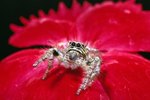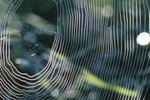
Spiders are the subject of many myths and half-truths, giving them a bad name with many humans. Nearly every spider species is venomous in some aspect -- they use venom to subdue their prey -- but few are of medical importance to humans. Two types of spiders in North America are capable of delivering medically significant bites to humans, although the introduction of antivenin has all but eliminated proper use of the word "deadly" to describe either.
Widow Spiders
Widow spiders belong to the genus Latrodectus in the family Theridiidae, commonly known as the cobweb weavers or comb-footed spiders. The black widows may be the most easily recognized and well-known venomous spiders due to the females' characteristic shiny black bodies and red, hourglass-shaped marking on their abdomen. The brown and red widow females also possess the red hourglass mark, although it is sometimes broken up, depending on the individual. Juveniles are often striped and spotted; males may be either solid colored or they maintain juvenile coloring. Black widows are native to the United States; brown widows are native to Africa and possibly South America.
Widow Spider Venom
Black widow venom causes an array of symptoms in victims including a numbing ache around the bite, painful cramps, severe abdominal cramps, raised blood pressure, tremors, vomiting and irregular heartbeat. Death occurs in less than 1 percent of victims; the most susceptible to severe symptoms and death are the very young and elderly. Although these spiders are generally timid and flee given the opportunity, bites are likely to occur when a human agitates the egg sac, web or accidentally presses against the spiders while grabbing what they have attached their webs to, such as wood in a backyard pile.
Loxosceles Spiders
Although the genus Loxosceles contains numerous species, only 11 are native to North America and only four of these are known to present potentially medically significant venom. The best known -- and subsequently, the one with the worst reputation -- is the brown recluse. Despite reports of brown recluse bites across the nation, these spiders only inhabit an area in the Midwest, Southeast and south-central states. Other species, such as the Arizona recluse, inhabit areas of the Southwest. Most have a distinct violin shape behind their eyes, although this is not an accurate way to identify recluse spiders. More accurate identifications can be made using the eye pattern: all Loxosceles spiders have six eyes arranged in a U-shaped pattern, instead of the more common eight eyes for arachnids.
Recluse Venom
Like the bite of the widow, the bite of a recluse isn't always immediately painful and many may not realize they've been bitten right away. Unlike widow venom, however, the danger of recluse bites is the necrotic properties. Recluse venom eats away and destroys the tissue around the bite; the bite begin to turn into a small blister after approximately seven hours and gets gangrenous, turns black and leaves a depression. The wound may be as small as a dime or more than 7 inches in diameter. In some cases, particularly sensitive people may encounter systemic reactions including chills, fever, jaundice, convulsions and death. Unfortunately for the recluse spiders' reputation, several necrotic dermanecrosis cases have been misdiagnosed as necrotic arachnidism when they are caused by something completely unrelated including staphylococcal or streptococcal infection, various herpes, syphilis, Lyme disease and anthrax.
References
- Burke Museum: The Spider Myths Site -- Myths About "Dangerous" Spiders
- Virginia Cooperative Extension: Widow Spiders
- University of California Statewide Integrated Pest Management Program: Black Widow and Other Widow Spiders
- Clinics in Dermatology: Loxoscelism
- Penn State College of Agricultural Sciences Entomology: Brown Recluse Spiders
- University of Minnesota Extension: Potentially Dangerous Spiders
Photo Credits
-
Creatas/Creatas/Getty Images
Writer Bio
With a professional background in gardening, landscapes, pests and natural ecosystems, Jasey Kelly has been sharing her knowledge through writing since 2009 and has served as an expert writer in these fields. Kelly's background also includes childcare, and animal rescue and care.



